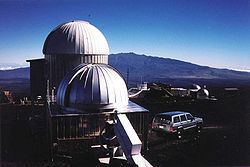Altitude 3,394 m | Established 1965 (1965) | |
 | ||
Organization | ||
Mauna Loa Solar Observatory (MLSO) is a solar observatory located on the slopes of Mauna Loa on the island of Hawaii in the U.S. state of Hawaii. It is operated by the High Altitude Observatory (HAO), a laboratory within the National Center for Atmospheric Research (NCAR). The MLSO sits on property managed by the Mauna Loa Observatory (MLO), which is part of the U.S. Department of Commerce National Oceanic and Atmospheric Administration (NOAA). MLSO was built in 1965.
Contents
The MLSO is tasked with monitoring the solar atmosphere and recording data on plasmic and energetic emissions from the chromosphere and corona. Studies of coronal mass ejections (CMEs) are also conducted at MLSO. A number of non-solar astronomical observatories are located at the site. The MLSO instruments record images of the solar disk and limb every 3 minutes for 3–10 hours daily starting at 17:00 UT, weather permitting.
